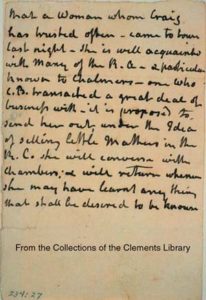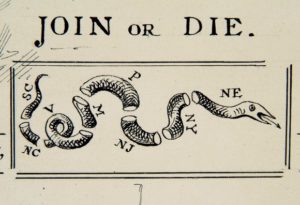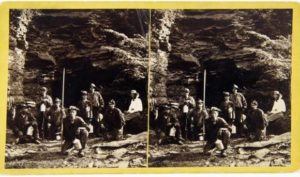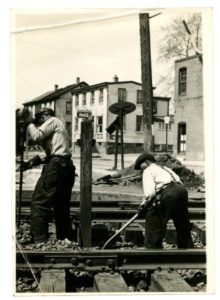Author: Tia D. Larese
School/Organization:
Penn Alexander School
Year: 2016
Seminar: Biography as History, or, Perhaps, History as Biography
Grade Level: 3
Keywords: biography, elementary, History, Philadelphia, revolutionary war, social studies, wax museum
School Subject(s): English, History, Social Studies
When faced with the every growing pressure of meeting common core standards in literacy, how can teachers make time to explore and expose their students to primary sources and real-life events, while also meeting the curriculum needs of teaching reading and writing? The answer: integration. This unit will look at history with a literary edge, teaching skills of sequence, cause-and-effect, making inferences, and informational writing while providing lessons and activities to encourage future historians to explore the city and people of Philadelphia, and incorporate aspects of theater education.
This curriculum was developed after taking a course about the relationships between history and biographies to learn about the key terms, skills, and concepts. Coupled with my own research about the history of Philadelphia and prominent voices of the times and knowledge of teaching 3rd grade, I pulled together resources and lessons to help engage 3rd graders in a lesson about history and biography while also meeting the needs of the literacy curriculum. Teachers can transport their class and their students’ families through the history of Philadelphia with a wax museum project that will be sure to hit on many of the necessary skills that students need to learn.
Download Unit: 16.01.06-unit.pdf
Did you try this unit in your classroom? Give us your feedback here.
There is a heavy emphasis in K-3 grades to develop a students reading and writing ability before they end 3rd grade. Students get at least 120 minutes of independent reading, writing, vocabulary, grammar, and spelling instruction daily, on average. In addition, students are also constantly being asked to develop their ability to read, write, and respond to texts in other subject areas, such as social studies, math and science, that it does not always leave teachers the opportunity to have student-led or hands-on learning in the classroom. As a result, there is a need for teachers to be intentional in making time to explore and exposing their students to primary sources and real-life events while also meeting the curriculum needs of teaching reading and writing.
This unit is intended for students in Grade 3 & 4. They spend most of the day in a self-contained classroom except for a 45-minutes specialist class each day, in addition to a 30-minutes lunch, and a 15-minute recess. Students take a Science class twice a week and work on three large units of study over the course of the year with that teacher, in addition to Art, Music, Gym, and Technology. The objectives of the unit will include the following:
This unit will include age-appropriate activities to develop literacy skills and engage students in hands-on discovery.
LESSON ONE: Building Background Knowledge Students will be able to (SWBAT): Identify key historical events in Philadelphia … in order to (IOT): understand the sequence of events on a timeline and also to see change over time and place. Overview: Students will work together in groups to analyze primary documents and photographs from different centuries in Philadelphia history focusing primarily on the of the 18th, 19th, and 20th centuries and major inventions or events that occurred that helped to mold Philadelphia into the city it is today. Then they will try to sequence Philadelphia history on a timeline. Then, teacher will review answers and explicitly teach facts and information to Philadelphia and its history. Ultimately the purpose of this activity is to encourage students to look deeper into a photograph or text in order make inferences about what is happening during the time period, find possible connections between the pictures and population growth, and to begin developing questions that may help them further investigate the lives of the people who lived in our city. Materials: Hook: I will bring in pictures of my family immigrating to the United States through Ellis Island. We will talk about how a picture or primary document can reveal a lot about a time period and the people that lived, as well as the events that were occurring. Teachers are encouraged to bring in something personal, if possible, or another primary source that connects. The teacher should model for the students how to “read a picture.” Namely, they should encourage students to begin developing and answering their own questions about the people, places, and items being highlighted. Students will work with partners to share their own pictures they brought in and practice how to read the picture their partner brought in. I See… I Wonder… (Who, What, Where, When, Why) I Think… I Want to Know… Task: Students will work in small groups to create a photograph-based timeline. They will first create a timeline that represents key years of population growth in the city of Philadelphia. They will then try to arrange the photographs along the timeline. For each photograph, they should also work as a group to describe what they think is happening in the primary photograph or text and how we can learn about the time period based on what we can learn from the text. Review: Students will hang up their timeline proposal and the teacher will go over the correct order of the photographs. The students will describe what they believe is in the pictures and the teacher will share some of the key events and inventions that impacted growth in Philadelphia. If time, students can suggest what time periods their own photographs will fall into. For next time: The students will complete an exit ticket about the experiences of making a timeline. They will write about (3) Facts they learned (2) Questions they still have and (1) Topic they want to learn more about. Students will have additional worksheets about timeline and sequence of events to practice the skill. EXIT TICKET 3 FACTS YOU HAVE LEARNED _______________________________________________________________________ _______________________________________________________________________ _______________________________________________________________________ 2 QUESTIONS YOU STILL HAVE _______________________________________________________________________ _______________________________________________________________________ 1 TOPIC YOU WANT TO LEARN MORE ABOUT _______________________________________________________________________ LESSON TWO: Biography Spotlight Students will be able to (SWBAT): Identify key details in a historical document or biography passage… in order to (IOT): explain the main idea of a historical text. Overview: It’s important for teachers to help students analyze different types of text from history. In this lesson, explain to students that they will read primary documents from the American Revolution, yet this work is applicable to many different time periods. Students will read about historical figures in Philadelphia history during the time of the American Revolution. Students will work with partners to present the main idea and details of the figures impact on Philadelphia. Not only should they talk about what they learn, but also what a specific text cannot teach them. This will help model for students identifying key details about a person and also help them to begin to grasp the concept that different texts offer different perspectives. Materials: Reading Materials: Biography of Ann Bates aka Mrs. Barnes & primary document of a letter about the spy. Biography of Benjamin Franklin & primary document of a cartoon by Franklin “Join or Die.” Biography George Washington. Biography Benjamin Franklin. Biography Betsy Ross. The specific biographies that can be used here are limitless and can feature different voices or points of view. Hook: Students will watch a video clip about the American Revolution. The teacher should explain that just like in photographs, videos, letters, biographies, and art can are different texts that they can study and learn more about a person, time period, or place. Before the video, the teacher will ask the students to think about two things. 1) What DID they learn from the video? 2) What DIDN’T they learn from the video? It’s vital for students to realize that they can learn different texts can share different types of information or perspectives. Task: Students will work in partnerships to read about a person of historical significance from the time period of the American Revolution. Each partnership will read an article and look at a primary document regarding a pre-selected individual. They will fill out a graphic organizer that is designed to find the main idea of the article, as well as provide key facts and details that they learn about the specific person. Then students will prepare a 1-3 minute presentation for the class about the main idea and key details they selected from the passage. TITLE: _____________________________________________________________ WHAT I LEARNED… DETAIL 1: __________________________________________________________ __________________________________________________________ __________________________________________________________ DETAIL 2: __________________________________________________________ __________________________________________________________ __________________________________________________________ DETAIL 3: __________________________________________________________ __________________________________________________________ __________________________________________________________ MAIN IDEA: __________________________________________________________ ___________________________________________________________ WHAT I DIDN’T LEARN… _______________________________________________________________________ _______________________________________________________________________ Review: Students will present their main idea and details for the class. After students are presenting, the teacher will ask classmates to repeat the main ideas/details about each biography and the teacher should record them on a collective SMARTboard page or whiteboard for students to monitor their active listening. As a whole class, they will discuss why each person was important or what that person’s biography might reveal about the time period. It will also be important to discuss how different texts revealed different types of information (or not). Teacher will probe students to think more about the fact that the biographies are from different points of view and we can learn a lot about a time period when we study different types of people. For next time: Students will get a fact sheet of famous and not-so-famous biographies from Philadelphia history. For homework, students should research and look up people on the list that they may be interested in learning more about, as well as people that may not be on the list but they discover through their research. Students should decide with a parent up to three potential biographies to study from Philadelphia history and be prepared to share them with their classmates. LESSON THREE: Research Students will be able to (SWBAT): Identify important facts and key details about a person… in order to (IOT): Describe their importance and contributions to Philadelphia history. Overview: Students will choose a time period of Philadelphia history that is interesting to them. From there, they will have the opportunity to choose from a pre-selected group of individuals or choose their own person to research that will offer multiple view points for the times. It is important for teachers to have a suggested list of biographies that may interest their students, but also be open for children to choose their own topic. It may be wise to have a limit of how many students can work within each time period to create an overall span of biographies for the end projects. Teacher will model research techniques and offer writing lessons to help students focus their writing. Materials: –Graphic organizers: Developing questions & Outlines -Bio pages for pre-selected individuals with primary documents -Computers -Biographical Book Selections Historical Figure: _______________________________________ EARLY LIFE: Birth – Death – CHARACTER TRAITS: FAMOUS FOR… INTERESTING FACTS: Hook: Students will watch a newscast (edited) about Hamilton: The Musical entitled “Hamilton: A founding father takes the stage” about how the writers, composers, and producers of the show had to do tremendous research about the founding father Alexander Hamilton to produce a creative piece of art. Task: The teacher will model how to fill out a K-W-L chart featuring the biography of someone that the class has already learned about. After that, the students will develop their questions and understanding on a KWL chart about the person they have chosen for their biography project. Emphasis will be placed on the students developing a list of questions that they want to know about their person. The teacher will create an anchor of “quintessential questions” that the students develop and can “borrow” from each other to find out more information. Another day, students will read bio pages and begin looking up information about their historical figure. The teacher will model a lesson about “how to take notes” which are put into their own words and do not encourage students not to copy facts from the books or passages they are reading. This lesson will take students some time to gather information and students are encouraged to find information at the local library, the historical society, at home, as well as during their independent reading time in class. What I Know What I Want To Know What I Have Learned Review: It’s important to monitor student thinking along the research process, especially to have them share new information they are learning or are thinking about. Students will play the game “Play the Post-it” at different points in the research process. At first, they will write down one question that they want to learn more information about their historical figure. Then later, they will write down one fact or piece of information they have learned about their historical figure. Some may even continue to add questions they still cannot find or questions about perspectives and the overall process. In the game, students take turns going around in a small group sharing. Each student will get a turn to talk about their questions or notes that they have written on the post-it, and then their classmates will have an opportunity to ask a question or make a comment to elicit discussion. STUDENT 1 POST-IT STUDENT 2 POST-IT PLAY THE POST-IT STUDENT 3 POST-IT STUDENT 4 POST-IT LESSON FOUR: Writer’s Workshop Students will be able to (SWBAT): in order to (IOT): Overview: Keep a pulse on the class research to find the best time to begin the writer’s workshop. If a child does not have enough information, they may become quickly discouraged. Students will use the information that they have collected about their person of interest and craft a presentation about their selected representative to share with families. Materials: Writer’s Notebook Graphic Organizers Anchor Charts Publishing Paper Hook: Teacher will model sample biography presentations about other historical figures. Students will work with writing partners to analyze the writing and jot on a post-it compliments and comments to share with the class. Task: The class will develop an anchor chart that outlines the key components of a biographical presentation based on their observations with their partner. Students will then have multiple class periods to plan, revise, and edit their own presentation with peer and teacher support. There will be a project rubric and overview to help guide students’ work. Speech Checklist ☐ Your speech should be around 1-3 minutes in length. ☐ You should write in first person (use I and me). ☐ INTRODUCTION: Start by introducing “yourself,” when/where your historical figure was born. ☐ Include important events from your childhood or education. ☐ Include information about why you are famous or well known. ☐ Include other interesting facts from your life or the time period. ☐ CONCLUSION: End with a powerful statement about the figure. Review: The class will have a symphony share and highlight the heart of their presentation with the class. For next time: Students will begin to plan for a background poster, clothes, and other props that they might find in a museum display about their historical figure. LESSON FIVE: Wax Museum Preparation & Performance Students will be able to (SWBAT):Identify key details about a historical figure… in order to (IOT): Understand and explain their contributions to society. Overview: Students will present a wax museum through Philadelphia history for families. Each student will dress up and present their point of view and effect on the times. Materials: Hook: Teacher will show students the Living Wax Museum video about a school that transformed their classroom into a museum and watch individual students dressed up in and speaking as though they are a specific historical figure. Task: This lesson will be two-fold, as part of this will give students preparation for the logistical aspects of the wax museum, but the other component will help students to become better public speakers. Students will plan a tri-fold board, costumes, and props for their wax museum display. Teacher will also offer a mini lesson about presentation skills and students will practice presenting their speech to the classroom without reading from a paper. Classmates will use a rubric to grade each other on oral communication and give compliments and comments to support students before parents visit for the wax museum. Teacher will go over the project rubric and students will take notes to be certain they understand all components. I. Research on Display Board (50 points) A. Historical Figure’s Name & Portrait (10 points) B. Background Information: (15 points) · Birth/Death – mandatory · Family (spouse, children, etc.) · Childhood · Education · Hobbies & Interests · Other important information C. Major Accomplishments (15 points) · List and describe this person’s major accomplishments · What was their major contribution to society? D. Presentation (10 points) · Creative, Organized, Neat II. Presentation (50 points) A. Historical Figure Portrayal (25 points) · Costumes, Props, Poses B. Oral Presentation (25 points) · Memorized · Eye Contact & Clear Review: Students will get to review feedback from peers and the teacher. At home and during free time in class, students will finalize their museum displays. The final performance will invite school community and family members into the school for their wax museum presentation.
YEAR Rank POPULATION
1790 2 28522
1800 2 41220
1810 2 53722
1820 2 63802
1830 3 80462
1840 4 93665
1850 4 121376
1860 2 565529
1870 2 674022
1880 2 847170
1890 3 1046964
1900 3 1293697
1910 3 1549008
1920 3 1823779
1930 3 1950961
1940 3 1931334
1950 3 2071605
1960 4 2002512
1970 4 1948609
1980 4 1688210
1990 5 1585577
2000 5 1517313
2010 5 1526006
K W L
PROJECT RUBRIC (100 points)
Reading List: Free Library of Philadelphia FAQs: https://libwww.freelibrary.org/faq/faqsubcat.cfm?FAQCategory=59&subcat=72 * This website is a great starting point for teachers to learn some basic facts and information about Philadelphia that students will be curious about. It’s a great springboard for further research. Primary Sources from the Historical Society of Pennsylvania (Online): http://hsp.org/education/for-teachers/educational-resources/primary-sources *Not only a great site for this particular curriculum, but a website with primary sources for teachers to utilize in their classroom across the disciplines. Teachers should pay special attention to the following images to include in the curriculum: *Ann Bates letter *Ben Franklin Cartoon *Coal Miners in PA *Railroad Workers Davis, Allen, and Mark H. Haller. “The Peoples of Philadelphia.” University of Pennsylvania Press. 1998. *All too often, history focuses on the exploits of those in power. This text features primary documents, statistics and a rare view into the more impoverished populations in the city’s history. As an educator, it gives great insight into different neighborhoods of the city. Mauger, Ed, and Bob Skiba. “Philadelphia: Then & Now.” Pavillion. 2015. *This is a text for both teachers and students alike with gripping images and well planned “then & now” shots to show the similarities and differences of the city over time. Not only are the pictures informative themselves, but also the captions and writing help the reader to learn more about the context from which each picture was taken. Bloom’s Taxonomy. <http://www.bloomstaxonomy.org/Blooms%20Taxonomy%20questions.pdf> *This site refers to the levels of questions to ask students to develop higher order thinking skills, which will help facilitate meaningful discussions, check for understand, and peak students’ interests when learning about history and biography. Teacher Resources: Boston University Population History Chart of Philadelphia: http://physics.bu.edu/~redner/projects/population/cities/philadelphia.html *This website offers a simplistic chart to represent Philadelphia’s growth in population from 1790 to 1990 by decade. Hamilton the Musical: https://www.youtube.com/watch?v=0wboCdgzLHg *This link offers a snapshot into the hit musical “Hamilton” and gives students a chance to see how history, biography, and theater collide. Scholastic Printables: https://printables.scholastic.com/shop/SearchCmd?Ntt=American+Revolution&storeId=12502&PrintableType=all *This website offers mini-books, fact & bio sheets, along with an assortment of printable activities to enhance any curricular unit. The Scholastic worksheets about Revolutionary figures are a great springboard for learning about famous Philadelphians. Wax Museum Lesson Plan: http://character.org/lessons/lesson-plans/elementary/alan-b-shepard-jr-elementary-school/ *This is one of many links that give an idea of the power of a “wax museum” approach to biography learning. Student Resources: Zschock, Martha Day. “Journey Around Philadelphia from A to Z” Commonwealth Editions. 2006. *This playful, alphabetical text couples learning about history with cultural awareness in an illustrated children’s book about Philadelphia. Fradin, Dennis Brindell. “Who Was Ben Franklin?” Grosset & Dunlap. 2002. *The “Who Was” series is a popular children’s book series that has brought focus on highlighting biographies of famous Americans. Buckley, James and Joe O’Brien. “Who Was Betsy Ross?” Grosset & Dunlap. 2014. *The “Who Was” series is a popular children’s book series that has brought focus on highlighting biographies of famous Americans. Benge, Janet. “William Penn: Liberty and Justice for all (Heroes of History).” Emerald Books. 2002. *An interesting read on the life of William Penn, giving insight to the time period. Saunders, Susan. “Margaret Mead: The World was Her Family.” Puffin Books. 2015. *An account of Mead’s life and contributions to anthropology. Sanders, Nancy. “America’s Black Founders.” Chicago Review Press. 2010. *A book featuring different biographies of African Americans who helped the fight for Independence. Davis, Burke. “Black Heroes of the American Revolution.” Odyssey Books. 1992. *These stories of black men and women from the Revolutionary era helps students get a well-rounded view on the contributions of many.



The Core Curriculum of the School District of Philadelphia is aligned to the Pennsylvania Academic Standards for Social Studies Education, as well as English Language Arts Standards. These standards include instruction on the following topics: Writing with different purposes, researching and reading for information, understanding different points of view, as well finding the relationships between historical events and people. Students will focus on writing informational texts, preparing speeches for a culminating wax museum, and making connections between Philadelphia now and then. CCSS.ELA-LITERACY.RI.3.1 – Ask and answer questions to demonstrate understanding of a text, referring explicitly to the text as the basis for the answers. CCSS.ELA-LITERACY.RI.3.10 -By the end of the year read and comprehend informational texts, including history/social studies texts, at the high end of the grades 2-3 text complexity band independently and proficiently. CCSS.ELA-LITERACY.RI.3.3 – Describe the relationship between a series of historical events, scientific ideas or concepts, or steps in technical procedures in a text, using language that pertains to time, sequence, and cause/effect.